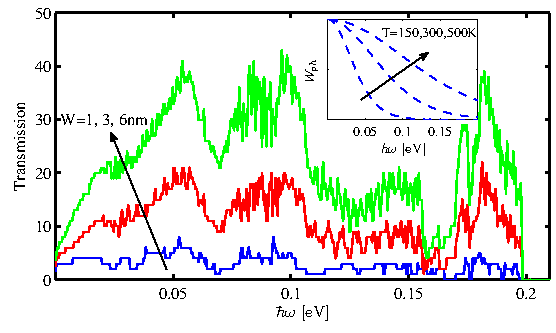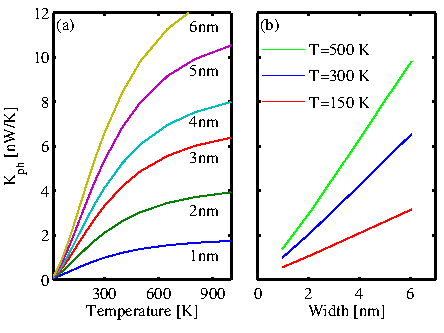The ballistic transmission function of phonons, which is the number of
phononic modes at some energy
![]() (Eq. 2.42), is shown in
Fig. 3.4. As expected, the transmission function
increases with the ribbon's width. In addition, the phononic window
function is shown in the inset of Fig. 3.4 at various
temperatures. This function, which qualifies the contribution of different
phonon frequencies in the thermal conductance, increases with
temperature. Therefore, at higher temperatures high energy phonons
will contribute to the thermal transport as well.
(Eq. 2.42), is shown in
Fig. 3.4. As expected, the transmission function
increases with the ribbon's width. In addition, the phononic window
function is shown in the inset of Fig. 3.4 at various
temperatures. This function, which qualifies the contribution of different
phonon frequencies in the thermal conductance, increases with
temperature. Therefore, at higher temperatures high energy phonons
will contribute to the thermal transport as well.

|

|
Figure 3.5-a and -b show the ballistic thermal conductance of
AGNRs as a function of temperature and the ribbon's width, respectively. By
increasing the temperature and thus the width of the phononic window function, the
thermal conductance increases. However, as the energy spectrum of
AGNRs is limited to
![]() (Fig. 3.4), the
thermal conductance saturates at very high temperatures (
(Fig. 3.4), the
thermal conductance saturates at very high temperatures (
![]() ). As shown in Fig. 3.5-b, the thermal
conductance increases linearly with the ribbon's width. In fact, the
ballistic thermal conductance divided by the width is
constant. This is due to the fact that by increasing the width and
thus the number of carbon atoms in the unit cell, the number of modes
increases almost linearly in the whole energy spectrum, and,
therefore, the ballistic transmission function is directly
proportional to the width.
). As shown in Fig. 3.5-b, the thermal
conductance increases linearly with the ribbon's width. In fact, the
ballistic thermal conductance divided by the width is
constant. This is due to the fact that by increasing the width and
thus the number of carbon atoms in the unit cell, the number of modes
increases almost linearly in the whole energy spectrum, and,
therefore, the ballistic transmission function is directly
proportional to the width.